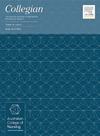护士对交接实践有效性的感知、影响因素和感知障碍:一项对内科和外科护士的描述性横断面研究
IF 1.7
4区 医学
Q2 NURSING
引用次数: 0
摘要
背景有效的交接可能会对患者造成伤害。目的本研究的目的是确定护士对交接过程有效性的感知,以及影响交接有效性的因素和感知障碍。方法采用单中心描述性横断面设计。这项研究是在土耳其地中海地区一家城市医院的内科和外科部门工作的249名护士中完成的。数据是在2023年7月至10月期间通过“个人信息表”和“交接评估量表”收集的。采用广义线性模型(GLM)分析,结合gamma分布和对数链接函数。本研究遵循了STROBE指南。结果HES总平均评分为56.0±6.9分。根据多变量GLM分析,女性护士(Exp(B)=1.062)、接受过交接培训的护士(Exp(B)=1.055)、使用表格、住院名单、病历等交接工具的护士(Exp(B)=1.077)的HES得分显著高于女性护士(p<;所有人都是05)。噪音、工作量和疲劳是影响有效交接的最常见障碍。讨论护士对交接有效性的感知较高,其HES总平均得分为80%(56.0/70)。性别、接受交接培训和使用表格、记录或清单与护士对交接有效性的看法有关。噪音是最常见的负面影响因素。研究结果可为进一步研究企业的交接有效性以及维持和提高交接有效性的策略提供参考。结论对交接有效性的高度认知对患者安全和护理的连续性具有重要意义。本研究显示了培训和规范化对交接有效性的重要性,以及控制负面影响交接过程的因素的必要性。本文章由计算机程序翻译,如有差异,请以英文原文为准。
Nurses' perceptions of the effectiveness of handover practices, influencing factors and perceived barriers: A descriptive cross-sectional study of medical and surgical nurses
Background
Ineffective handover may lead to patient harm.
Aim
The purpose of this study is to determine nurses’ perceptions of the effectiveness of the handover process and the factors that influence handover effectiveness and perceived barriers.
Methods
A single-centre descriptive cross-sectional design was used. The study was completed with 249 nurses working in the medical and surgical units of a city hospital in the Mediterranean region of Turkey. Data were collected with the ‘Personal Information Form’ and ‘Handover Evaluation Scale (HES)’ between July and October 2023. The generalised linear model (GLM) analysis with gamma distribution and log link function was used. The STROBE guidelines were followed in the study.
Findings
The HES total mean score was 56.0 ± 6.9. According to the multivariable GLM analysis, female nurses (Exp(B)=1.062), those who received handover training (Exp(B)=1.055), and those who used handover tools such as forms, inpatient lists, or records (Exp(B)=1.077) had significantly higher HES scores (p<.05 for all). Noise, workload, and tiredness were the most frequently reported barriers to effective handover.
Discussion
Nurses’ perceptions of handover effectiveness were high, with a total mean score on the HES of 80% (56.0/70). Sex, receiving handover training, and using forms, records, or lists were associated with nurses’ perceptions of handover effectiveness. Noise was the most frequent negative influencing factor. The findings may be useful for further studies on the handover effectiveness and strategies to maintain and improve effectiveness.
Conclusion
The high perceptions of handover effectiveness are important for patient safety and care continuity. This study showed the importance of training and standardisation in handover effectiveness and the need to control factors that negatively affect the handover process.
求助全文
通过发布文献求助,成功后即可免费获取论文全文。
去求助
来源期刊

Collegian
NURSING-
CiteScore
2.70
自引率
6.70%
发文量
127
审稿时长
72 days
期刊介绍:
Collegian: The Australian Journal of Nursing Practice, Scholarship and Research is the official journal of Australian College of Nursing (ACN).
The journal aims to reflect the broad interests of nurses and the nursing profession, and to challenge nurses on emerging areas of interest. It publishes research articles and scholarly discussion of nursing practice, policy and professional issues.
Papers published in the journal are peer reviewed by a double blind process using reviewers who meet high standards of academic and clinical expertise. Invited papers that contribute to nursing knowledge and debate are published at the discretion of the Editor.
The journal, online only from 2016, is available to members of ACN and also by separate subscription.
ACN believes that each and every nurse in Australia should have the opportunity to grow their career through quality education, and further our profession through representation. ACN is the voice of influence, providing the nursing expertise and experience required when government and key stakeholders are deciding the future of health.
 求助内容:
求助内容: 应助结果提醒方式:
应助结果提醒方式:


